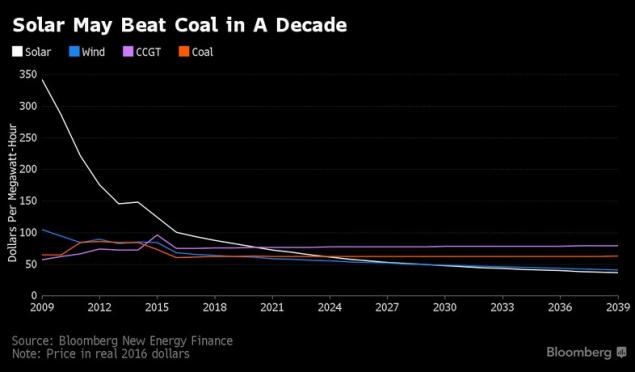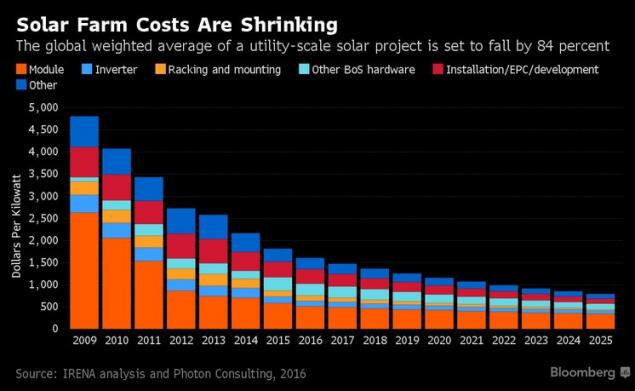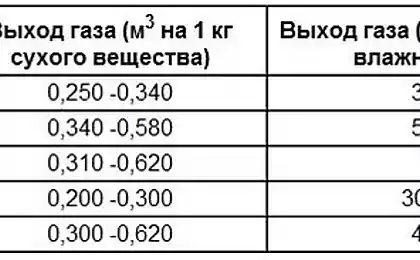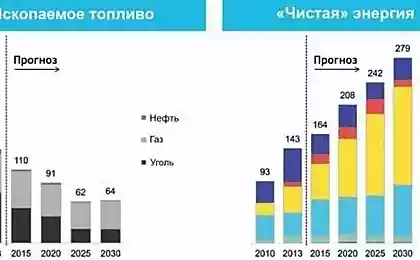576
Why will solar energy become cheaper than coal within 10 years
Today solar energy is already cheaper than coal in some regions. In the next ten years, it is likely to become the cheapest source of energy around the world.
In 2016, in countries such as Chile or the United Arab Emirates were delivered record sales of solar energy at a price not exceeding 3 cents per 1 kWh, which is approximately equal to half of the global average cost of energy produced by coal-fired power plants. However, this year Saudi Arabia, Mexico and Jordan plan to go further and make it even cheaper. The same applies to many European companies, which today are seeking new markets as solar power does not need subsidies.

Since 2009, solar prices have fallen 62%, while costs are significantly reduced in each link of the supply chain. This is due to cheaper Bank loans because of reduced risks and increased production to record levels. According to Bloomberg New Energy Finance, by 2025, solar energy could become cheaper than the energy of the average coal in the world.
"It figures that change the rules of the game and they become normal in a growing number of markets, says Adnan Amin, Director General of the International Agency on renewable energy of the intergovernmental group of Abu Dhabi. — Every time you double the performance, you reduce the price by 20 percent,".
Technology development plays a key role in promoting the industry. Also, last but not least this is due to economies of scale and the accumulation of work experience, since "solar" boom began over a decade ago, giving industry more and more advantages in the competition with fossil fuels.
The average solar power plant with capacity over 1 MW will cost $0,73 per watt by 2025, compared to $1.14 per watt currently, which means a reduction by 36%, predicts Jenny chase, head of solar energy analysis for New Energy Finance.
This prediction is consistent with other forecasts:
The rate at which the price of solar energy drops below the coal will be different in each country. Regions that import a lot of coal, such as Europe and Brazil, will approach the tipping point no later than early 2020. from countries with large domestic reserves of solid hydrocarbons such as India and China, apparently, it will take more time.
Adherents of hydrocarbons
Supporters of the coal industry argue that when comparing renewable and conventional energy sources is not taken into account the cost of backup energy storage systems that are utilized in periods, for example, the lack of sun and wind. If the calculations to include these expenses, the coal seems to be more economical, even up to 2035, says Benjamin Sporton, Director General of the world Association of coal.
"All countries with developed economies need electricity 24 hours a day — says Sporton. — The wind and the sun can "work" only part-time, generating electricity intermittently. While some renewable technologies have achieved substantial cost reduction in recent years, it is very important to look at the total cost of the system."However, the fall in the price of solar energy is gradually and steadily makes the technology a real competitor.

According to New Energy Finance, China is the world's largest solar market – a noticeable decline in prices relative to coal can be seen by 2030. Today this country is ahead of Germany in the number of solar power plants, however, many projects cannot use their full potential in the Sunny regions of the country, because the congestion of the networks does not allow to get them at full capacity.
We will remind, in August, auction in Chile showed the result of 2.91 cents per kWh of solar energy. In September, the United Arab Emirates reached $ 2.42 cents per kWh And in December a new record was set by the Danish energy sector, selling "clean" energy of 1.81 cents per kW*h. published
Source: ecotechnica.com.ua/energy/solntse/1915-pochemu-solnechnaya-energiya-stanet-deshevle-uglya-uzhe-v-techenii-10-let.html
In 2016, in countries such as Chile or the United Arab Emirates were delivered record sales of solar energy at a price not exceeding 3 cents per 1 kWh, which is approximately equal to half of the global average cost of energy produced by coal-fired power plants. However, this year Saudi Arabia, Mexico and Jordan plan to go further and make it even cheaper. The same applies to many European companies, which today are seeking new markets as solar power does not need subsidies.

Since 2009, solar prices have fallen 62%, while costs are significantly reduced in each link of the supply chain. This is due to cheaper Bank loans because of reduced risks and increased production to record levels. According to Bloomberg New Energy Finance, by 2025, solar energy could become cheaper than the energy of the average coal in the world.
"It figures that change the rules of the game and they become normal in a growing number of markets, says Adnan Amin, Director General of the International Agency on renewable energy of the intergovernmental group of Abu Dhabi. — Every time you double the performance, you reduce the price by 20 percent,".

Technology development plays a key role in promoting the industry. Also, last but not least this is due to economies of scale and the accumulation of work experience, since "solar" boom began over a decade ago, giving industry more and more advantages in the competition with fossil fuels.
The average solar power plant with capacity over 1 MW will cost $0,73 per watt by 2025, compared to $1.14 per watt currently, which means a reduction by 36%, predicts Jenny chase, head of solar energy analysis for New Energy Finance.
This prediction is consistent with other forecasts:
- GTM Research expects that some States in the South-Western United States today are approaching $1 per watt, and can reach 75 cents in 2021.
- National laboratory of renewable energy of the U.S. Department of energy suggests that costs about $1.20 per watt at present, will be reduced to $1 by 2020.
- The international energy Agency expects that the costs of energy companies for generation of solar energy will drop by 25 percent on average over the next five years.
- The international Agency for renewable energy implies a further reduction in price of solar energy in the range of from 43 to 65 percent by 2025. This will lead to a cumulative decline in prices by 84 percent since 2009.
The rate at which the price of solar energy drops below the coal will be different in each country. Regions that import a lot of coal, such as Europe and Brazil, will approach the tipping point no later than early 2020. from countries with large domestic reserves of solid hydrocarbons such as India and China, apparently, it will take more time.
Adherents of hydrocarbons
Supporters of the coal industry argue that when comparing renewable and conventional energy sources is not taken into account the cost of backup energy storage systems that are utilized in periods, for example, the lack of sun and wind. If the calculations to include these expenses, the coal seems to be more economical, even up to 2035, says Benjamin Sporton, Director General of the world Association of coal.
"All countries with developed economies need electricity 24 hours a day — says Sporton. — The wind and the sun can "work" only part-time, generating electricity intermittently. While some renewable technologies have achieved substantial cost reduction in recent years, it is very important to look at the total cost of the system."However, the fall in the price of solar energy is gradually and steadily makes the technology a real competitor.

According to New Energy Finance, China is the world's largest solar market – a noticeable decline in prices relative to coal can be seen by 2030. Today this country is ahead of Germany in the number of solar power plants, however, many projects cannot use their full potential in the Sunny regions of the country, because the congestion of the networks does not allow to get them at full capacity.
We will remind, in August, auction in Chile showed the result of 2.91 cents per kWh of solar energy. In September, the United Arab Emirates reached $ 2.42 cents per kWh And in December a new record was set by the Danish energy sector, selling "clean" energy of 1.81 cents per kW*h. published
Source: ecotechnica.com.ua/energy/solntse/1915-pochemu-solnechnaya-energiya-stanet-deshevle-uglya-uzhe-v-techenii-10-let.html























